
First, let’s review: since 2009, almost all smartphones have been equipped with ARM processors, achieving a performance increase of 100 times. Just think, in just seven years, 100 times, what an astonishing number! Thanks to the significant performance improvement, new features, ultra-fast user interface responses, and immersive user experiences have become a reality, while power consumption remains unchanged, overcoming various challenges in mobile device design. Undoubtedly, this is an unprecedented achievement in engineering technology history.
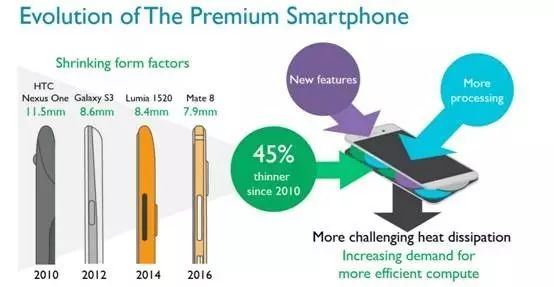
High performance, new features, and optimized user experiences continuously drive rapid market growth. It is predicted that global smartphone sales will exceed 1.5 billion units in 2016.
With the push of consumer trends, smartphone design has become an important platform for future innovation in many aspects. Augmented Reality (AR), Virtual Reality (VR), ultra-high-definition visualization, object-based audio processing technology, and computer vision all demand higher system performance; coincidentally, smartphones have been pursuing thinner designs in recent years, sacrificing heat dissipation performance to some extent, while also raising higher demands for power management. Additionally, as smartphone sizes have reached the limit of convenient operation, it means that increasing battery capacity through device volume cannot be achieved. To continue the glorious decade of the smartphone industry, further optimize immersive user experiences, and lead future innovations, we must continue to optimize performance and improve energy efficiency.
As of now, ARM has released its new high-performance processor, Cortex-A73. Following the launch of the Cortex-A72 processor last year, ARM has accelerated innovation and introduced the new Cortex-A73 processor this year; this processor will be fully applied to high-end smartphones in early 2017.
Thanks to exclusive design and optimization, the Cortex-A73 processor is tailor-made for mobile devices and other consumer electronics. The optimizations made by the Cortex-A73 for device performance and energy consumption are particularly exciting:
• Excellent performance of mobile power circuits, with a maximum frequency of 2.8GHz
• 30% improvement in power efficiency, ensuring the best user experience
• Built into the smallest ARMv8-A architecture to date
From the early stages of product development, the goal of the Cortex-A73 has been very clear: to create the most energy-efficient and highest-performing ARM processor.
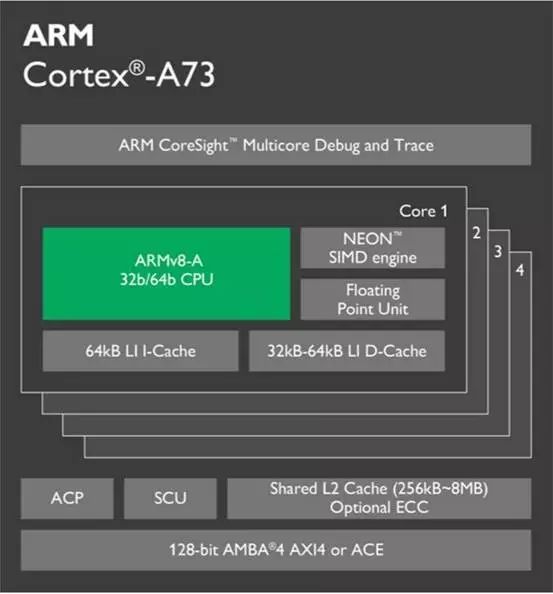
Cortex-A73: ARMv8-A High-Performance Processor
The Cortex-A73 processor fully supports the ARMv8-A architecture, and its feature set perfectly fits smartphones and other consumer electronics. The ARMv8-A architecture employs ARM TrustZone technology, NEON technology, visualization, and cryptographic design, allowing the Cortex-A73 to support the broadest range of mobile applications and middleware ecosystems (mobile software development and optimization are primarily based on ARM architecture) whether the system is 32-bit or 64-bit.
The Cortex-A73 processor is equipped with a 128-bit AMBA 4 ACE interface, ensuring perfect compatibility with high-efficiency Cortex-A53 for high-end designs or the new ultra-high-efficiency Cortex-A35 for mid-range and cost-sensitive designs.
Best Performance
The Cortex-A73 processor is tailor-made for the next generation of high-end smartphones. Under the 10nm process, the Cortex-A73 has improved sustained performance by 30% compared to the previous Cortex-A72 high-performance CPU. At a frequency of 2.8GHz, the Cortex-A73 remains powerful, perfectly matching sustained energy efficiency. As shown in the figure below, the Cortex-A73 can still run normally close to peak frequency. Although actual operating frequencies will be limited, and it rarely runs at full frequency, this test still confirms the powerful performance of the Cortex-A73.
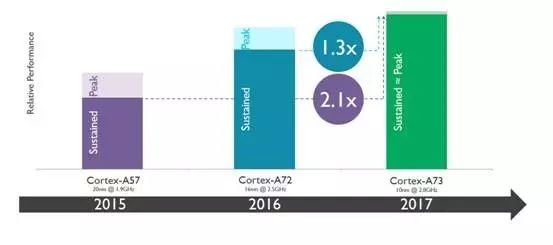
Performance Optimization for Mobile Devices
The Cortex-A73 processor supports a 64kB instruction cache (based on advanced algorithms for branch prediction) and high-performance instruction prefetching. The main performance optimization lies in the data storage system, utilizing advanced L1 and L2 data prefetching and supporting complex pattern detection. Additionally, it has optimized storage buffers for continuous data writing streams and increased data cache to 64kB without causing any timing impact.
Compared to Cortex-A72, thanks to the optimizations and improvements mentioned above, mobile application performance running at the same frequency on Cortex-A73 can be improved by up to 10%. Chip designs based on Cortex-A73 have pushed frequency optimization further than previous generations; in addition, compared to Cortex-A72, the new Cortex-A73 processor improves performance by at least 15% across all storage workload application environments, including multi-application, operating system operation, and NEON complex computation execution.
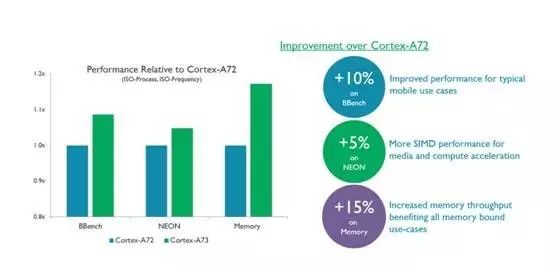
Power Consumption Optimization
Although the power consumption of Cortex-A73 is lower than that of Cortex-A72, performance has significantly improved. The Cortex-A73 has undergone substantial upgrades in clock gating control, power-optimized RAM architecture, and resource-sharing execution optimization for AArch32/AArch64, further reducing power consumption.
Compared to Cortex-A72, the Cortex-A73 saves at least 20% power for integer workloads; optimizations for floating-point calculations and memory access workloads are even more pronounced. The reduction in power consumption significantly enhances user experience and extends battery life; at the same time, power consumption optimization allows SoCs to save more dynamic headroom, improving system and graphics processor performance, achieving better visual effects, increasing frame rates, and laying the groundwork for the addition of new features.
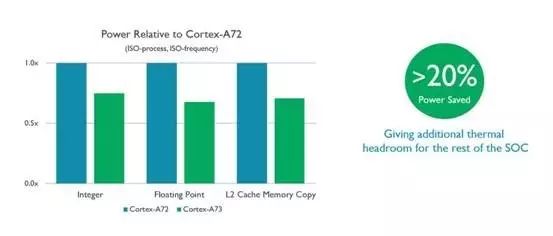
The Smallest High-End ARM CPU to Date
In addition to achieving extremely high sustained and peak performance, the most noteworthy feature of the Cortex-A73 is its ability to deliver the outstanding performance of high-end processors based on ARMv8-A architecture in the smallest area, safeguarding the rapidly rising mid-range smartphone market; and achieving the best user experience at a medium to low cost. Thanks to technological innovations, the new Cortex-A73 processor is smaller in area compared to the Cortex-A15 that uses the ARMv7-A architecture. Specifically, compared to Cortex-A57 and Cortex-A72, the area of Cortex-A73 is reduced by 70% and 42%, respectively. According to international standards, the core size of Cortex-A73 is reduced by up to 25% compared to Cortex-72. In addition to playing a role in advanced technology nodes such as 16nm and 10nm processes, the Cortex-A73 processor also shines in the 28nm technology node of the mass market, significantly improving the performance of mid-range mobile devices.
Reducing area allows devices to accommodate more chips, integrate more functions, or improve the performance of other system IPs, which can also reduce the SoC and device costs for mid-range mobile devices.
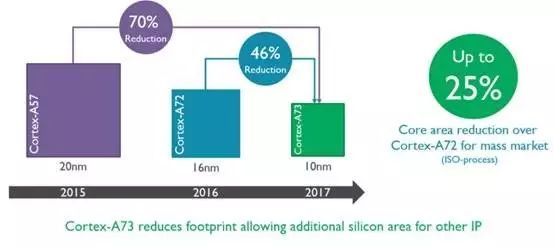
Comprehensive Performance Improvement for Mid-Range Smartphones
Using big.LITTLE technology and CoreLink CCI, ARM provides excellent scalability for partners, achieving system optimization and creating differentiated products. What does this mean? SoC designs can use 1 or 2 big cores and 2 or 4 small cores, with performance and user experience that can even rival high-end designs. The unique L2 cache is reduced to 1MB, but still ensures sufficient cache to support the normal operation of big cores under actual high-performance workloads. Based on the energy efficiency model, big.LITTLE software can be flexibly configured to meet the needs of different application environments.
Currently, big.LITTLE technology has been widely deployed in the mobile device market. The Cortex-A73 and Cortex-A53 will jointly serve the next generation of smartphones, most commonly integrated into octa-core processors. Additionally, the Cortex-A73 has laid the foundation for enhancing the mid-range user experience. For example, a six-core big.LITTLE configuration, with a dual-core Cortex-A73 processor and a quad-core Cortex-A53 or Cortex-A35 processor, can achieve better performance than an octa-core Cortex-A53 in the same or smaller area. This topology has become quite common and has been successfully applied to entry-level and mid-range devices. Due to the reduced response time for applications such as web browsing and scrolling interfaces, the six-core Cortex-A73 outperforms the octa-core Cortex-A53 by 30%, with single-thread peak performance doubling, significantly enhancing user experience.
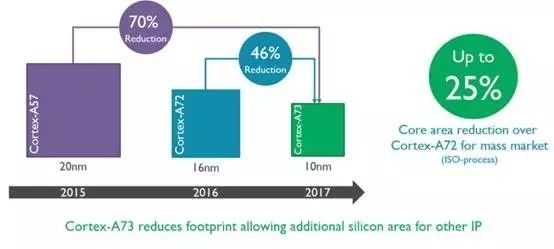
The ARM design team continuously enhances user experience, fully leveraging the unique characteristics of mobile devices based on ARM architecture: equipping the Cortex-A73 processor to achieve better performance and longer battery life with less power consumption and smaller space. Later this year into 2017, the Cortex-A73 processor will gradually cover a range of consumer electronics, including high-end smartphones, tablets, flip mobile devices, and digital TVs, from our partners. Let us wait and witness the emergence of these products!

1.Book Recommendations | 7 New Books Recommended for Programmers this Summer
2.The concept of “pragmatic computing” has been proposed for the first time. Do you know what it is?
3.SoftBank Acquires ARM. Is the Japanese ARM still the same ARM?
4. The last ITRS roadmap: the era of hardware first is about to end!
5. 9 Bad Programming Habits Loved by Programmers. How many have you changed?
6. The real advantages of Linux and how to learn it

Disclaimer: This article is a network reprint, and the copyright belongs to the original author. If there are any copyright issues, please contact us, and we will confirm the copyright based on the copyright certificate you provide and pay the remuneration or delete the content.